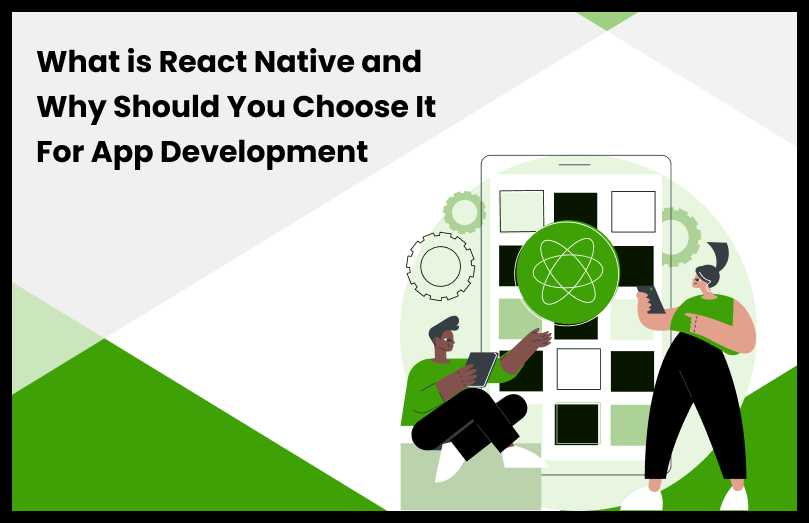The market for developing mobile applications has expanded substantially over the past few years.
According to Statista reports, by 2023, there will be 299 billion app installs annually, up from 194 billion in 2018.
Are you looking for a dependable and efficient way to develop mobile applications that work perfectly on different platforms? The only choice is React Native. Have you heard about React Native? What is React Native?
A mobile app development framework that is user-friendly, affordable, and interoperable across the iOS and Android systems always constitutes an intelligent choice, but this differs from organization to organization. Developing a mobile application is the best approach to capitalizing on this explosive increase for your company and this can be best possible with mobile app development services.
We’ll talk about one of the most efficient development tools, React Native, in this blog article, along with the advantages it makes an excellent foundation for creating commercial mobile apps.
Let’s begin!
What Language is React Native and its Innovations in 2023?
React Native is an open-source framework developed by Facebook for building mobile applications. It is used in both the front and back end of websites, facilitating the development of full-stack online applications. It enables developers to produce fast, native mobile applications for iOS and Android using the well-liked React JavaScript library.
You may improve your application’s efficiency and responsiveness by selecting React Native, thanks to ongoing enhancements and updates. Main improvements for 2023 include the following:
- The 0.68 edition marks the debut of the new structure. It features TurboModules, a novel native modular approach, and Fabric Renderer, a unique rendering system. This module improves the interaction between JavaScript and native code. Also, a brand-new renderer created in C++ and utilized by all systems makes it simpler to adapt React Native to various operating systems.
- With the introduction of edition 0.70, Hermes is the default engine, which reduces the size of an Android file and speeds up the application’s startup time. Despite a possible modest increase in an iOS file size, memory use decreases.
What is React Native Used For?
React Native was once regarded as commercially unsustainable. Creating “native-like” applications just wasn’t sufficiently established or enabled.
Nevertheless, times have altered. Recognition, community engagement, and customer base for React Native are all growing. React Native is making it simpler to create fantastic applications, and people are becoming aware of it.
Tested and Reliable
To build an excellent mobile application for the company’s social platform, Facebook used React Native first instead of others. Most probably, you’ve utilized it via the Facebook mobile smartphone application. Does the app have a native feeling to it? Indeed, it does.
Notwithstanding, more businesses have chosen to wager on React Native and develop their mobile applications in this manner as it has become open-source. Here are a few examples of the best native applications: Tesla, Skype, Facebook, Walmart, Bloomberg, and Discord.
Based on a Single Codebase
You can write a single codebase for two different platforms, Android and iOS, employing React Native. React Native explicitly builds a link among web Ui elements and respective native Java/Swift equivalents. Moreover, it generates native Java and Swift code rather than just “working.”
Consider how your product might be affected. With two platforms, it’s unnecessary to have dual development teams. There is no requirement to synchronize layouts and functionality. In simple terms, you advance more quickly and use your resources better.
Choose the Language You are Familiar With
React Native apps can be built with less specialized skills. You probably have an existing team member who is proficient in JavaScript, and maybe ReactJS in particular. Relative to experts specializing in Java or Swift, JS programmers are simpler to find.
Although if the front-end programmer hasn’t ever worked using React Native, through some knowledge, they can pick it up extremely fast, mainly if they’ve worked with React prior. To get started, you must devote some time to researching which online elements connect to which elements of mobile.
Continually Expanding
The advancement of React Native is ongoing. The enormous React Native team and Facebook are actively trying to enhance the framework. If React Native lacks an answer to the issue you are currently facing, things may change within a couple of months.

What are the Features of React Native?
Finding React, iOS, or Android developers can be a little tricky. But, the procedure is made a little bit simpler by being aware of a mobile app development framework’s basic capabilities. The following are the main components of React Native mobile app development:
- Components: They serve as the foundation for any React Native programme. A component is a repeatable section of code that operates according to its logic. Every React app has a variety of components, which may be functional or class-based.
- Unidirectional Data Binding: The function connects a user interface component to a specific data point. Improved app management ensures the procedure, which is one-way. One-way data binding, in other words, guarantees that one modification seems not to affect the application’s code.
- JavaScript and XML: This feature directly extends the syntax used in JavaScript. The way the Ui must appear and function is informed to React by developers using JavaScript XML.
- DOM Virtual: All of the modifications introduced to the application are represented in the features. The system contrasts the latest edition with an earlier version To upgrade the app seamlessly.
What are the Key Plus Points of React Native?
You may create a functional mobile app using React Native, comparable to an Objective-C or Java-coded programme. Here are the main points of React Native.
- Utilizing web technologies, programmers may construct mobile applications with React Native. So, by utilizing React Native, a developer skilled in website development may easily create a mobile application.
- Using JavaScript elements on either iOS or Android elements, React Native enables programmers to create cross-platform applications that appear entirely to be native. When programmers do not need to produce a similar program for many systems, it cuts considerable money and time. Also, because there’s just one codebase for an app created using React Native, maintenance is more straightforward.
- A developer doesn’t need to master complex languages like Objective-C or Java to build a smartphone application because React Native employs JSX.
- To integrate Native apps across both systems using JavaScript, hire expert react native app developer employs essential Android as well as iOS building elements. Because of this, managing the program code is made more straightforward, and adding new functionality is made simpler when the application is functioning.
- React Native would be ideal for customers with stringent financial and time limitations. They save a tonne of time and funds by not having to create numerous versions of the same program for various platforms. They aren’t sacrificing quality either, owing to React Native. To generate a Native experience for an application on several devices, JavaScript compiles the coding. Additionally, React Native offers great UI/UX and security aspects that Hybrid apps frequently lack.
- You can develop applications more quickly with React Native. One can rapidly reload an application rather than recompile it. You also might execute innovative functionalities while keeping your entire application by utilizing its Hot Reloading capability.
- React Native offers various frameworks and tools, including Jest, ESLint, Expo, and Redux, making designing and evaluating functionality simple.
- React Native offers a strong development community.
- React Native apps are swifter and more flexible in addition to becoming reactive and offering an excellent UX.
Conclusion
With seamless graphics and quick load times, React Native promises top-notch performance. It also boasts a sizable developer community that actively contributes to its growth, ensuring it keeps up with the most recent technological advancements and capabilities.
It is a productive framework for programmers, a lucrative company solution, and an acceptable consumer option. So, React Native is the only option to consider if you want to create a cross-platform mobile application. Contact the top React Native app development agency MMF InfoTech’s to receive the most excellent services available.


